Marie Brennan's Blog, page 211
February 28, 2012
Angsty Fun Times
![[info]](https://i.gr-assets.com/images/S/compressed.photo.goodreads.com/hostedimages/1380923608i/3292608.gif) alecaustin
and I had a long conversation today about how fiction sometimes needs to have depiction of horrible things, and the fine line between "necessary horrible" and "voyeuristic horrible," and the way that readers have sometimes been conditioned toward voyeurism regarding horrible things (see: the problem of depicting rape), and so on. And he got me wondering what I would consider to be the worst violence I've inflicted on a character of mine.
alecaustin
and I had a long conversation today about how fiction sometimes needs to have depiction of horrible things, and the fine line between "necessary horrible" and "voyeuristic horrible," and the way that readers have sometimes been conditioned toward voyeurism regarding horrible things (see: the problem of depicting rape), and so on. And he got me wondering what I would consider to be the worst violence I've inflicted on a character of mine.Off the top of my head, I decided it was the stuff that happens to Seniade in drafts of what eventually became Dancing the Warrior . It isn't actually the most damaging violence -- she doesn't die of it -- but it's horrible because it's being done to her by a sadist, and she knows it, and she accepts it because she think it's what she needs to do. Plus I dwell on the details of it, the step-by-step process and the pain that follows, which I don't generally do otherwise. I called it "borderline torture" in that conversation, and only leave it at "borderline" because Sen could walk away at any time.
For all that, though -- as I told
![[info]](https://i.gr-assets.com/images/S/compressed.photo.goodreads.com/hostedimages/1380923608i/3292608.gif) alecaustin
-- it bothers me less than, say, the plague stuff I wrote for In Ashes Lie. Partly because Sen volunteers for it, but partly because most of us are desensitized to violence. And then that made me realize that what I find "worst" about the DtW stuff isn't the physical suffering after all, but the psychological: what's going on inside Sen's head. (Which is why it's the drafts, not the final version, that are the worst. One of them -- not so much a draft as an exercise -- is a pure, unadulterated inner monologue.)
alecaustin
-- it bothers me less than, say, the plague stuff I wrote for In Ashes Lie. Partly because Sen volunteers for it, but partly because most of us are desensitized to violence. And then that made me realize that what I find "worst" about the DtW stuff isn't the physical suffering after all, but the psychological: what's going on inside Sen's head. (Which is why it's the drafts, not the final version, that are the worst. One of them -- not so much a draft as an exercise -- is a pure, unadulterated inner monologue.)And then I started thinking, you know, that might be why I tend to prefer torturing my characters psychologically, rather than physically. Because it bothers me a lot more. <g>
I've known for a long time that I'm a sucker for suffering and angst. It only works if you get me to really care about the character first; angst in an unlikeable or boring character will just make me roll my eyes. And it has to be the right kind of suffering; my taste tends toward the operatic end of the spectrum, rather than the grinding, day-to-day banality of things like "how will I find the money for rent this month." But if you hit the right notes, on a character I'm invested in? I will eat it up with a spoon.
I can't say it's fun, exactly. "Magnetic" would be more apt. The next-to-last scene of the film The Wind That Shakes the Barley is excruciating to watch; something truly horrible happens, and there's no resolution afterward to let me feel it's All Okay Now. But it's an amazing scene. (One which I didn't see until after A Star Shall Fall was over and done with -- but if you want to know what psychological note I was aiming for near the end of that book, watch the movie. Or, y'know, watch it just because it's a bloody brilliant piece of work from Cillian Murphy. It's streaming on Netflix, and worth it for the ending alone.) I can't look away from such things, and they stay with me long after they're over.
Really, it's cathartic. And yet -- why do I enjoy the experience? Why am I so often a sucker for drama over comedy? And what determines what kind of suffering I'll enjoy, versus what will just depress me? I'm still working on the answers to that. So I'm curious to know how others feel about this kind of thing. Do you like angst, and if so, what kinds, under what circumstances? Which kinds of suffering bother you more, and which are you desensitized to? What can you bear to write, versus read, versus watch?
I'm hoping your answers will help me understand what's going on in my own head. :-)
Published on February 28, 2012 23:56
observations from tonight's round of letter-writing
1) I should have written Irrith's letter after Delphia's. She's a terrible influence on my attempts at nice handwriting. :-)
2) Re-reading bits of the books to get myself back in the heads of the characters . . . and you know what? I still like them. Quite a lot.
3) Certain songs from the book soundtracks still get me right in the gut. (Particularly "The Monument," from A Star Shall Fall. But others, too.)
4) I really, really need to write that short story about Edward Thorne. Though I should decide which I want more: for it to be from his point of view, or for it to be the Sir Peregrin and Dame Segraine Buddy-Cop Extravaganza. (The two are, alas, mutually exclusive.)
5) Ditto "This Living Hand," aka the Story About the Willow Tree What Killed All the Romantic Poets.
6) Although I do love my new series, and my new protagonist . . . I miss the Onyx Court.
2) Re-reading bits of the books to get myself back in the heads of the characters . . . and you know what? I still like them. Quite a lot.
3) Certain songs from the book soundtracks still get me right in the gut. (Particularly "The Monument," from A Star Shall Fall. But others, too.)
4) I really, really need to write that short story about Edward Thorne. Though I should decide which I want more: for it to be from his point of view, or for it to be the Sir Peregrin and Dame Segraine Buddy-Cop Extravaganza. (The two are, alas, mutually exclusive.)
5) Ditto "This Living Hand," aka the Story About the Willow Tree What Killed All the Romantic Poets.
6) Although I do love my new series, and my new protagonist . . . I miss the Onyx Court.
Published on February 28, 2012 10:48
con updates
First of all: I regret to say that I will not, after all, be going to ICFA this year. It's the week before FOGcon, and doing both back-to-back last year was really draining. Add in the fact that I'm already heavily booked for cons and other appearances this year -- not to mention that it costs a lot more time and money both to get out to Florida, now that I'm on the West Coast -- and I'm just going to have to pass this year.
I'm delighted with my schedule for FOGcon, though. They haven't posted the panel descriptions yet, so all I have to share with you are titles, times, and panelists, but these look pretty good:
Judging a Book by the Girl on Its Cover - Friday, 3:00 p.m. (Jaym Gates, Marie Brennan, Jean Marie Stine, Elsa Hermens)
Equal Time for Non-Vampires - Friday, 4:30 p.m. (Mickey Phoenix, Anaea Lay, Marie Brennan, Jaym Gates)
Roll 1d6 on the Plot Hooks Table - Saturday, 8:00 p.m. (Marie Brennan, Steven Schwartz, Gary Kloster, Alec Austin, Alyc Helms)
Mutations/X-Men - Sunday, 1:00 p.m. (Ian Hagemann, Katie Sparrow, Marie Brennan, Naamen Tilahun)
Reading - Sunday, 1:30 p.m. (Marie Brennan, David Levine, Phoebe Wray)
Plus the writers' workshop, which I'm doing with David Levine and Cassie Alexander.
I'm particularly looking forward to the "Plot Hooks" panel, which is about the relationship between gaming and fiction: Alec and Alyc are both in my writers' group, Alyc is running a Pathfinder game Alec and I are playing in, and the gaming history between me and Alyc . . . it goes back twelve years, if you count the jerry-built Changeling game she ran during Castell Henllys field school, which led to me playing in the Bloomington Changeling LARP, which led to me running Memento, which led to the Onyx Court series. To name just one example.
Think we'll find anything to talk about? :-)
I'm delighted with my schedule for FOGcon, though. They haven't posted the panel descriptions yet, so all I have to share with you are titles, times, and panelists, but these look pretty good:
Judging a Book by the Girl on Its Cover - Friday, 3:00 p.m. (Jaym Gates, Marie Brennan, Jean Marie Stine, Elsa Hermens)
Equal Time for Non-Vampires - Friday, 4:30 p.m. (Mickey Phoenix, Anaea Lay, Marie Brennan, Jaym Gates)
Roll 1d6 on the Plot Hooks Table - Saturday, 8:00 p.m. (Marie Brennan, Steven Schwartz, Gary Kloster, Alec Austin, Alyc Helms)
Mutations/X-Men - Sunday, 1:00 p.m. (Ian Hagemann, Katie Sparrow, Marie Brennan, Naamen Tilahun)
Reading - Sunday, 1:30 p.m. (Marie Brennan, David Levine, Phoebe Wray)
Plus the writers' workshop, which I'm doing with David Levine and Cassie Alexander.
I'm particularly looking forward to the "Plot Hooks" panel, which is about the relationship between gaming and fiction: Alec and Alyc are both in my writers' group, Alyc is running a Pathfinder game Alec and I are playing in, and the gaming history between me and Alyc . . . it goes back twelve years, if you count the jerry-built Changeling game she ran during Castell Henllys field school, which led to me playing in the Bloomington Changeling LARP, which led to me running Memento, which led to the Onyx Court series. To name just one example.
Think we'll find anything to talk about? :-)
Published on February 28, 2012 00:38
February 27, 2012
Last call for Onyx Court letters
February is nearly over, and with it, the Month of Letters! You have a few days yet in which to write a letter to the Onyx Court; I promise to answer anything mailed to me before the end of the week (to give a few days' grace period).
And then we'll have the fun of seeing how long it takes the inkstains to fade from my fingers. :-) (No really, that trope of bookish types in fantasy having stained fingers? It's totally true. I just wonder if there's some trick I'm missing for not leaving little inky fingerprints on other parts of the page, because nobody every mentions that bit.)
And then we'll have the fun of seeing how long it takes the inkstains to fade from my fingers. :-) (No really, that trope of bookish types in fantasy having stained fingers? It's totally true. I just wonder if there's some trick I'm missing for not leaving little inky fingerprints on other parts of the page, because nobody every mentions that bit.)
Published on February 27, 2012 21:56
for those with an interest in LARPs
My friend
![[info]](https://i.gr-assets.com/images/S/compressed.photo.goodreads.com/hostedimages/1380937898i/3402594.gif) mikevonkorff
has been doing a series of posts about live-action roleplaying games -- their design and execution, what players look for in a game and how they pursue it, etc. Chewy stuff, especially since a lot of his commentators are part of a circle that has played a bunch of games together, but I'm coming from a totally different gaming community. Makes for some very enlightening comparisons.
mikevonkorff
has been doing a series of posts about live-action roleplaying games -- their design and execution, what players look for in a game and how they pursue it, etc. Chewy stuff, especially since a lot of his commentators are part of a circle that has played a bunch of games together, but I'm coming from a totally different gaming community. Makes for some very enlightening comparisons.
I'm taking a particular interest in this because![[info]](https://i.gr-assets.com/images/S/compressed.photo.goodreads.com/hostedimages/1380937898i/3402594.gif) kniedzw
and I are likely to be running a one-shot LARP based on Changeling: The Dreaming in a few months. (If you're in the San Francisco Bay Area, will be around Memorial Day weekend, and think you might like to play, drop me a line.) I haven't done a lot of LARP-running, so it helps to watch other people talk about the stuff you need to consider, and the different ways those topics can be approached. Especially when those people do things very differently than I do.
kniedzw
and I are likely to be running a one-shot LARP based on Changeling: The Dreaming in a few months. (If you're in the San Francisco Bay Area, will be around Memorial Day weekend, and think you might like to play, drop me a line.) I haven't done a lot of LARP-running, so it helps to watch other people talk about the stuff you need to consider, and the different ways those topics can be approached. Especially when those people do things very differently than I do.
Anyway, if you have any interest in the topic, check his posts out. And feel free to jump in, even on the older posts; the more perspectives, the merrier.
![[info]](https://i.gr-assets.com/images/S/compressed.photo.goodreads.com/hostedimages/1380937898i/3402594.gif) mikevonkorff
has been doing a series of posts about live-action roleplaying games -- their design and execution, what players look for in a game and how they pursue it, etc. Chewy stuff, especially since a lot of his commentators are part of a circle that has played a bunch of games together, but I'm coming from a totally different gaming community. Makes for some very enlightening comparisons.
mikevonkorff
has been doing a series of posts about live-action roleplaying games -- their design and execution, what players look for in a game and how they pursue it, etc. Chewy stuff, especially since a lot of his commentators are part of a circle that has played a bunch of games together, but I'm coming from a totally different gaming community. Makes for some very enlightening comparisons.I'm taking a particular interest in this because
![[info]](https://i.gr-assets.com/images/S/compressed.photo.goodreads.com/hostedimages/1380937898i/3402594.gif) kniedzw
and I are likely to be running a one-shot LARP based on Changeling: The Dreaming in a few months. (If you're in the San Francisco Bay Area, will be around Memorial Day weekend, and think you might like to play, drop me a line.) I haven't done a lot of LARP-running, so it helps to watch other people talk about the stuff you need to consider, and the different ways those topics can be approached. Especially when those people do things very differently than I do.
kniedzw
and I are likely to be running a one-shot LARP based on Changeling: The Dreaming in a few months. (If you're in the San Francisco Bay Area, will be around Memorial Day weekend, and think you might like to play, drop me a line.) I haven't done a lot of LARP-running, so it helps to watch other people talk about the stuff you need to consider, and the different ways those topics can be approached. Especially when those people do things very differently than I do.Anyway, if you have any interest in the topic, check his posts out. And feel free to jump in, even on the older posts; the more perspectives, the merrier.
Published on February 27, 2012 10:35
February 23, 2012
Things Not to Say
Hey, guys?
If you are upset about something, and you want to yell at somebody about it, it's worth taking a moment to make sure you're yelling at the right person.
For example, do not blame the author for Amazon's decision to ship print copies of a novel two weeks before the sale date, but not to send out the e-books at the same time. Aside from the fact that retailers aren't supposed to ship anything before the street date, the author has precisely ZERO control over what Amazon chooses to do. (And is probably even more upset than you are, because that potentially screws her over in career-affecting ways.)
And if you are upset about something, take a careful look at how you're expressing your feelings.
For example, is it productive to call the author "stupid," "greedy," "ungrateful," or "a narcissist"? Probably not.
And it is definitely not productive -- nor even okay -- to call her a "bitch," a "whore," or a "cunt."
Seriously. The person on the other end of that e-mail you're about to send? Is a person. One who, in this case, has no actual control over the thing you are upset about; she didn't cause it, and she can't fix it, and she's upset about it, too. But even if those things weren't true . . . what the hell, people. How fragile is your world if the UTTER APOCALYPTIC DISASTER of NOT BEING ABLE TO GET YOUR E-BOOK NOW NOW NOW justifies heaping misogynistic abuse on the person who produces the thing you love?
Please. Be smart enough to aim your criticism in an appropriate direction, not at a fellow victim. But more than anything . . . act like a human, not a hyena.
If you are upset about something, and you want to yell at somebody about it, it's worth taking a moment to make sure you're yelling at the right person.
For example, do not blame the author for Amazon's decision to ship print copies of a novel two weeks before the sale date, but not to send out the e-books at the same time. Aside from the fact that retailers aren't supposed to ship anything before the street date, the author has precisely ZERO control over what Amazon chooses to do. (And is probably even more upset than you are, because that potentially screws her over in career-affecting ways.)
And if you are upset about something, take a careful look at how you're expressing your feelings.
For example, is it productive to call the author "stupid," "greedy," "ungrateful," or "a narcissist"? Probably not.
And it is definitely not productive -- nor even okay -- to call her a "bitch," a "whore," or a "cunt."
Seriously. The person on the other end of that e-mail you're about to send? Is a person. One who, in this case, has no actual control over the thing you are upset about; she didn't cause it, and she can't fix it, and she's upset about it, too. But even if those things weren't true . . . what the hell, people. How fragile is your world if the UTTER APOCALYPTIC DISASTER of NOT BEING ABLE TO GET YOUR E-BOOK NOW NOW NOW justifies heaping misogynistic abuse on the person who produces the thing you love?
Please. Be smart enough to aim your criticism in an appropriate direction, not at a fellow victim. But more than anything . . . act like a human, not a hyena.
Published on February 23, 2012 21:43
February 22, 2012
The Wheel of Time Plan -- including bonus fundraiser!
Okay, so after some reflection, here's the plan.
I'm going to delay posting about the novels until later this year -- probably starting in September, with two posts each for The Gathering Storm and Towers of Midnight. The first post will be pure reader reaction (as pure as I can make it, anyway), and the second will be analysis.
In between now and then, I will post about related WoT things. Which ones? Well, that depends on you.
There is a companion book, a short story (which I think is in the companion book), a role-playing game, a video game, and some comic books. I own the first (and therefore possibly the second), but none of the rest, and unlike the usual novels, I can't obtain them from libraries. Ergo, investigating these things would require me to shell out money as well as time. But, on the other hand, I don't actually want to solicit money from you guys for what amounts to a random hobby project.
Stick a pin in that for a second, and follow me down a divergent thread, which is that I am deeply furious with the retrograde stuff going on right now in the United States with regard to gender and reproduction. I won't get into specifics, because I don't want to turn this into a political thread -- but that collided in my head with some of the complaints I've made about gender in this series, and lo, an idea was born.
It goes like this: donate to a charity that supports women and/or their right to control their own bodies, and I will subject myself to assorted bits of Wheel of Time merchandising for your entertainment.
It looks like it'll cost me about $25 a pop to obtain the RPG book and the video game, so let's set those as our minima: if you guys raise twenty-five dollars, I'll read and report back on the RPG, and if you raise fifty, I'll do the same for the video game. Seventy-five gets you a more fully-baked version of my homebrew hack for a Wheel of Time RPG, and a hundred gets you a solemn promise that I'll play the entire video game, come hell, high water, or my complete suckitude at first-person shooters. And if you raise $150 or more, I'll even hunt down the comic books -- which are a rehash of New Spring and The Eye of the World, rather than new material, which is why I'm putting them last.
Donate to a suitable charity -- you pick which one -- and e-mail me a copy of the receipt at marie[dot]brennan[at]gmail[dot]com. I'll keep a running tally. There's no immediate deadline; this part of the project is intended to occupy me through August, so you can donate at any point before then. But do feel free -- nay, encouraged -- to signal-boost. At a time like this, when a congressional representative can think it's even remotely excusable to convene a panel on the topic of birth control and stock it entirely with men, I'd like to see women's rights get a bit of support.
I'm going to delay posting about the novels until later this year -- probably starting in September, with two posts each for The Gathering Storm and Towers of Midnight. The first post will be pure reader reaction (as pure as I can make it, anyway), and the second will be analysis.
In between now and then, I will post about related WoT things. Which ones? Well, that depends on you.
There is a companion book, a short story (which I think is in the companion book), a role-playing game, a video game, and some comic books. I own the first (and therefore possibly the second), but none of the rest, and unlike the usual novels, I can't obtain them from libraries. Ergo, investigating these things would require me to shell out money as well as time. But, on the other hand, I don't actually want to solicit money from you guys for what amounts to a random hobby project.
Stick a pin in that for a second, and follow me down a divergent thread, which is that I am deeply furious with the retrograde stuff going on right now in the United States with regard to gender and reproduction. I won't get into specifics, because I don't want to turn this into a political thread -- but that collided in my head with some of the complaints I've made about gender in this series, and lo, an idea was born.
It goes like this: donate to a charity that supports women and/or their right to control their own bodies, and I will subject myself to assorted bits of Wheel of Time merchandising for your entertainment.
It looks like it'll cost me about $25 a pop to obtain the RPG book and the video game, so let's set those as our minima: if you guys raise twenty-five dollars, I'll read and report back on the RPG, and if you raise fifty, I'll do the same for the video game. Seventy-five gets you a more fully-baked version of my homebrew hack for a Wheel of Time RPG, and a hundred gets you a solemn promise that I'll play the entire video game, come hell, high water, or my complete suckitude at first-person shooters. And if you raise $150 or more, I'll even hunt down the comic books -- which are a rehash of New Spring and The Eye of the World, rather than new material, which is why I'm putting them last.
Donate to a suitable charity -- you pick which one -- and e-mail me a copy of the receipt at marie[dot]brennan[at]gmail[dot]com. I'll keep a running tally. There's no immediate deadline; this part of the project is intended to occupy me through August, so you can donate at any point before then. But do feel free -- nay, encouraged -- to signal-boost. At a time like this, when a congressional representative can think it's even remotely excusable to convene a panel on the topic of birth control and stock it entirely with men, I'd like to see women's rights get a bit of support.
Published on February 22, 2012 10:51
Anatomy of a Ninteenth-Century Penmanship System
One week (plus a leap day) left to get a letter from the Onyx Court! (I'm slightly behind on answering a few letters I've received, but vow not to let "slightly" become "a lot.")
A while ago I mentioned the Spencerian System of Practical Penmanship, which![[info]](https://i.gr-assets.com/images/S/compressed.photo.goodreads.com/hostedimages/1384762371i/6957336.gif) kniedzw
had bought a while ago -- a reproduction of an 1864 course in penmanship. I struggled with the conflicting impulses to doooooo iiiiiiiit and to run far, far away, and ended up falling partial victim to the former. Being a grown adult with fine motor control and experience in writing, I decided I didn't need to fill out every workbook in its entirety . . . but it wouldn't hurt me to do the first line of each page.
kniedzw
had bought a while ago -- a reproduction of an 1864 course in penmanship. I struggled with the conflicting impulses to doooooo iiiiiiiit and to run far, far away, and ended up falling partial victim to the former. Being a grown adult with fine motor control and experience in writing, I decided I didn't need to fill out every workbook in its entirety . . . but it wouldn't hurt me to do the first line of each page.
(This was mostly true. Hand cramps were, however, a genuine factor.)
So if you would like to follow me on my odyssey through the nineteenth century -- including many illustrative photos -- come behind the cut . . . .
So it starts out sensibly, with straight lines and basic curves (concave and convex both).
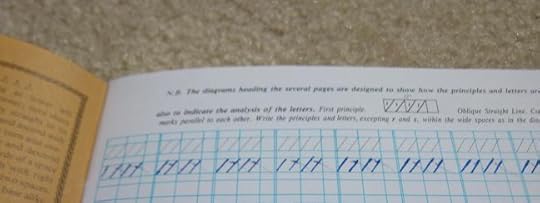
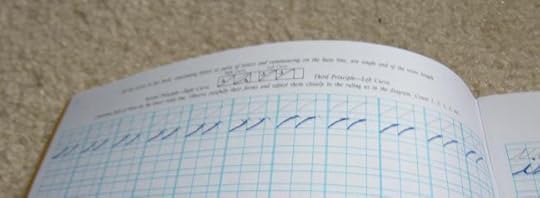
These are the First, Second, and Third Principles of the system, and you commence to practicing some letters that use them, singly and in random combinations:
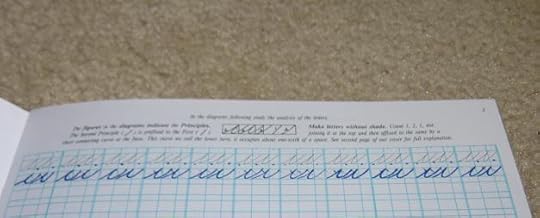
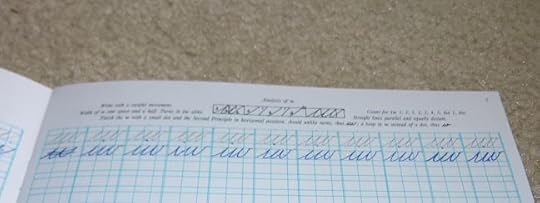
I find myself starting to disagree with the penmanship system when it introduces its c's, though. Compare these facing pages, with e's on the left and c's on the right:

That bitty loop thing at the top of the c makes it rather easy, I think, to mistake for an e. (Especially when, as you can see in my example, you don't draw it very well -- but I think it's a problem even in a good hand.)
Furthermore, this illustrates one of the flaws of the "system," which is that it starts off with its tidy little principles, but those don't hold up for very long once you get past the simplest letters. There ought to be a principle for the turn that joins the left and right curves of the e, but instead the book just waves that away. This pattern will continue, and get worse as we go along.
We continue on through s's and r's (which likewise get handwaved away as being totally built off the same three principles, even when they're not), and start getting into more letter combinations, and so on through the end of the first of five booklets.

So far, so good. In the second booklet, we will presumably start in on the other kinds of letters, like t's and f's and so on.
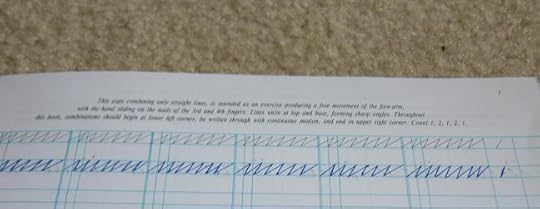
. . . okay, joined diagonals first. And then more i's and u's and w's, n's and m's, and x's, with the numerals tossed randomly at the ends of the lines, with no actual notes on those; you're just supposed to copy them, without instruction.
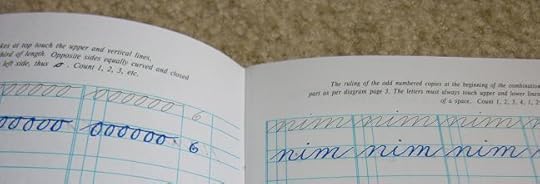
(Incidentally, you can tell it's around here that I started to get sloppy. I have some quite beautiful examples in the first workbook, but it's all downhill from this point.)
On through more a's, i's, m's, e's, n's, c's -- haven't we done this stuff before? -- "cam," r's, "ruin," s's, "some," "utui," "dim," -- whoa! All of a sudden we have some new letters, taller ones, that we haven't practiced before, and we're doing them with much less of a printed guidance grid than we had before. But then it's back to "mew" and "max" and "mice" and things we've done before. Ummm . . . .

And then it's time for the third workbook, where we no longer have a grid at all -- just lines, printed much more closely-spaced than before. A few pages in, we're facing this:
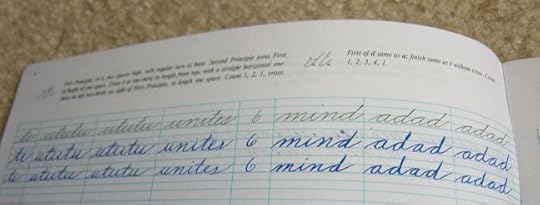
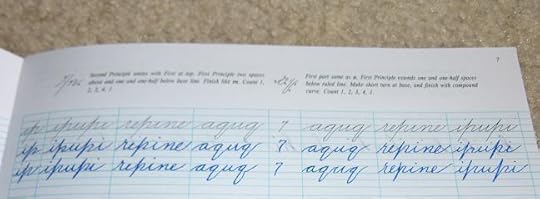
We spent two entire workbooks on repeating the same small letters over and over again, but now we get a bunch of new letters dumped on us with no basic practice at all. And the instructions try to pretend this is just the same stuff we've been doing before -- First Principle, Second, Third -- which it sort of is . . . but you know, not quite, and not to the extent that we wouldn't benefit from drawing those weird p's and q's in a proper grid for a while.
Or, y'know, the t's and d's we had before, or the h's, k's, l's, b's, y's, g's, f's, and z's that appear over the next four pages. Oh, yeah -- four pages is all we get, before suddenly it's time for this:
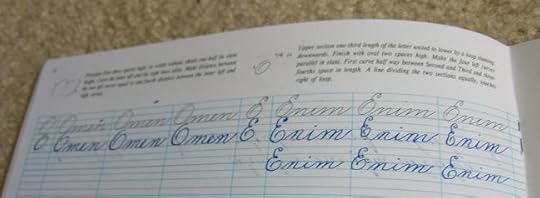
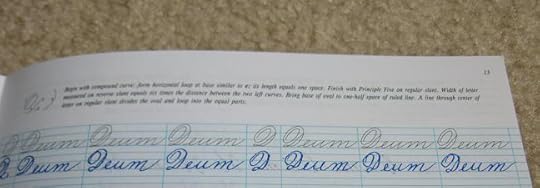
Capitals! Which are very ornate! And we haven't practiced at all!
There's a vague mention of how the swoops up and down on the lower-case f are the Fourth Principle, and the Fifth Principle is (apparently) the Third, just done, uh, bigger or something, but it gets less than a tenth of the attention paid to all those u's we drew for two books straight.
Ah, Victorian psueod-science. The Spencerian System puts on a veneer of being all organized and stuff, boiling the letters down to basic common elements, but it's no more than a veneer. As we go on through the capitals, we will be subjected to all kinds of flourishes that, okay, all consist of curves -- but it would be a hell of a lot more useful if, say, the intro swirl on that D were treated as a unit, and we were set to practice it a bunch of times before we started attaching it to various letters.
It's also unnecessary, but hey -- this is Victorian penmanship. I have to accept a certain amount of decoration. Not, however, this much:
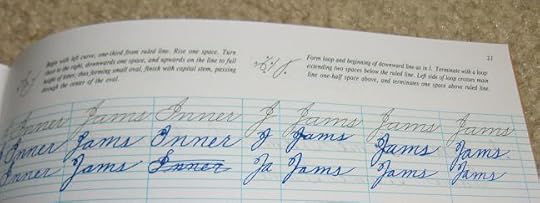
As you can see, I utterly suck at the capital I's and J's. But that I! Seriously! I hardly even know where to begin. (And the instructions aren't helpful on that front, either. It doesn't tell you where to start the letter, or whether you should do it in multiple strokes or a continuous one; it just tells you this is composed of the Second and Third Principles. Uh-huh.)
One book ago, we were still on a handful of letters. Now we've done all the rest, and most of the capitals. There are a few more to go, and they aren't getting any better:

One book of those, and then it's time for sentences! Every last one of them a tedious platitude, selected for brevity (so you can write it twice on each line) and its opening capital. We begin with A, and go through to Z:


And we're done! You have learned the entire Spencerian (Pseudo-)System of (Im)Practical Penmanship.
The most beneficial thing I got from this was the early stuff, with the most detailed grid to help guide my lines. A lot of making your cursive look good is a matter of consistent slant -- which you can see I got worse about as I went on -- and the grid is helpful for that. The more ornate capitals are also nice for Onyx Court usage, since certain characters are more likely to be elaborate in their writing. But as an actual system? It's terrible. It isn't actually half as systematized as it pretends to be, and it spends too long on the basics, then not remotely long enough on the more complicated stuff.
As a historical document, it's interesting. But I don't recommend it for actual practice.
. . . and if you get an Onyx Court letter with some really awkward-looking capitals, you'll know to blame P.R. Spencer. :-)
A while ago I mentioned the Spencerian System of Practical Penmanship, which
![[info]](https://i.gr-assets.com/images/S/compressed.photo.goodreads.com/hostedimages/1384762371i/6957336.gif) kniedzw
had bought a while ago -- a reproduction of an 1864 course in penmanship. I struggled with the conflicting impulses to doooooo iiiiiiiit and to run far, far away, and ended up falling partial victim to the former. Being a grown adult with fine motor control and experience in writing, I decided I didn't need to fill out every workbook in its entirety . . . but it wouldn't hurt me to do the first line of each page.
kniedzw
had bought a while ago -- a reproduction of an 1864 course in penmanship. I struggled with the conflicting impulses to doooooo iiiiiiiit and to run far, far away, and ended up falling partial victim to the former. Being a grown adult with fine motor control and experience in writing, I decided I didn't need to fill out every workbook in its entirety . . . but it wouldn't hurt me to do the first line of each page.(This was mostly true. Hand cramps were, however, a genuine factor.)
So if you would like to follow me on my odyssey through the nineteenth century -- including many illustrative photos -- come behind the cut . . . .
So it starts out sensibly, with straight lines and basic curves (concave and convex both).


These are the First, Second, and Third Principles of the system, and you commence to practicing some letters that use them, singly and in random combinations:


I find myself starting to disagree with the penmanship system when it introduces its c's, though. Compare these facing pages, with e's on the left and c's on the right:

That bitty loop thing at the top of the c makes it rather easy, I think, to mistake for an e. (Especially when, as you can see in my example, you don't draw it very well -- but I think it's a problem even in a good hand.)
Furthermore, this illustrates one of the flaws of the "system," which is that it starts off with its tidy little principles, but those don't hold up for very long once you get past the simplest letters. There ought to be a principle for the turn that joins the left and right curves of the e, but instead the book just waves that away. This pattern will continue, and get worse as we go along.
We continue on through s's and r's (which likewise get handwaved away as being totally built off the same three principles, even when they're not), and start getting into more letter combinations, and so on through the end of the first of five booklets.

So far, so good. In the second booklet, we will presumably start in on the other kinds of letters, like t's and f's and so on.

. . . okay, joined diagonals first. And then more i's and u's and w's, n's and m's, and x's, with the numerals tossed randomly at the ends of the lines, with no actual notes on those; you're just supposed to copy them, without instruction.

(Incidentally, you can tell it's around here that I started to get sloppy. I have some quite beautiful examples in the first workbook, but it's all downhill from this point.)
On through more a's, i's, m's, e's, n's, c's -- haven't we done this stuff before? -- "cam," r's, "ruin," s's, "some," "utui," "dim," -- whoa! All of a sudden we have some new letters, taller ones, that we haven't practiced before, and we're doing them with much less of a printed guidance grid than we had before. But then it's back to "mew" and "max" and "mice" and things we've done before. Ummm . . . .

And then it's time for the third workbook, where we no longer have a grid at all -- just lines, printed much more closely-spaced than before. A few pages in, we're facing this:


We spent two entire workbooks on repeating the same small letters over and over again, but now we get a bunch of new letters dumped on us with no basic practice at all. And the instructions try to pretend this is just the same stuff we've been doing before -- First Principle, Second, Third -- which it sort of is . . . but you know, not quite, and not to the extent that we wouldn't benefit from drawing those weird p's and q's in a proper grid for a while.
Or, y'know, the t's and d's we had before, or the h's, k's, l's, b's, y's, g's, f's, and z's that appear over the next four pages. Oh, yeah -- four pages is all we get, before suddenly it's time for this:


Capitals! Which are very ornate! And we haven't practiced at all!
There's a vague mention of how the swoops up and down on the lower-case f are the Fourth Principle, and the Fifth Principle is (apparently) the Third, just done, uh, bigger or something, but it gets less than a tenth of the attention paid to all those u's we drew for two books straight.
Ah, Victorian psueod-science. The Spencerian System puts on a veneer of being all organized and stuff, boiling the letters down to basic common elements, but it's no more than a veneer. As we go on through the capitals, we will be subjected to all kinds of flourishes that, okay, all consist of curves -- but it would be a hell of a lot more useful if, say, the intro swirl on that D were treated as a unit, and we were set to practice it a bunch of times before we started attaching it to various letters.
It's also unnecessary, but hey -- this is Victorian penmanship. I have to accept a certain amount of decoration. Not, however, this much:

As you can see, I utterly suck at the capital I's and J's. But that I! Seriously! I hardly even know where to begin. (And the instructions aren't helpful on that front, either. It doesn't tell you where to start the letter, or whether you should do it in multiple strokes or a continuous one; it just tells you this is composed of the Second and Third Principles. Uh-huh.)
One book ago, we were still on a handful of letters. Now we've done all the rest, and most of the capitals. There are a few more to go, and they aren't getting any better:

One book of those, and then it's time for sentences! Every last one of them a tedious platitude, selected for brevity (so you can write it twice on each line) and its opening capital. We begin with A, and go through to Z:


And we're done! You have learned the entire Spencerian (Pseudo-)System of (Im)Practical Penmanship.
The most beneficial thing I got from this was the early stuff, with the most detailed grid to help guide my lines. A lot of making your cursive look good is a matter of consistent slant -- which you can see I got worse about as I went on -- and the grid is helpful for that. The more ornate capitals are also nice for Onyx Court usage, since certain characters are more likely to be elaborate in their writing. But as an actual system? It's terrible. It isn't actually half as systematized as it pretends to be, and it spends too long on the basics, then not remotely long enough on the more complicated stuff.
As a historical document, it's interesting. But I don't recommend it for actual practice.
. . . and if you get an Onyx Court letter with some really awkward-looking capitals, you'll know to blame P.R. Spencer. :-)
Published on February 22, 2012 00:45
February 18, 2012
account hack
One of my gmail accounts got hacked. So, first of all, my apologies to anybody who got hit with spam because of me.
Second -- since this is the first time this has happened to me -- tips for what I should do? I've already changed my password, and as I type this, I have a program scrubbing my computer for malware. I don't know if there are things I should do beyond that, though.
Other than find the person responsible and stab them in the face.
Second -- since this is the first time this has happened to me -- tips for what I should do? I've already changed my password, and as I type this, I have a program scrubbing my computer for malware. I don't know if there are things I should do beyond that, though.
Other than find the person responsible and stab them in the face.
Published on February 18, 2012 02:16
a saga of ye gods and little stick figures
I know some of you read
The Order of the Stick
, one of the oldest and best D&D parodies on the web. But whether you do or not, I have to direct you, with suitable awe, at the saga of its Kickstarter project.
Creator Rich Burlew set out to raise $57,750 to get one of the collections, War and XPs, back into print. He blew through that goal in less than twenty-four hours. As I write this post, he has raised $868,072 -- and that number will certainly have gone up by the time I hit "post."
You can follow the tale via the project updates. Scroll down to the bottom to find the first one, and then do the same for the more recent ones. It is, I think, an amazing testament both to what Kickstarter can do, and how to do a Kickstarter project well. Burlew has done an excellent job of adapting to the overwhelming success of his fundraiser; not only did he rapidly set new goals (reprinting other out-of-print books, increasing print runs, covering the increased expenses for all the rewards packages), he found a lot of clever ways to reward people for their support. And throughout, he's been highly transparent about the entire process, so that nobody is going to walk away thinking he's put their money to a use they didn't expect. (If anybody is displeased with what he's done so far, they're still free to cancel their support: nothing is final until the fundraiser ends.)
It's a marvel in a number of respects. And if you have any interest in this kind of crowdsourcing model, his experience is worth studying.
Creator Rich Burlew set out to raise $57,750 to get one of the collections, War and XPs, back into print. He blew through that goal in less than twenty-four hours. As I write this post, he has raised $868,072 -- and that number will certainly have gone up by the time I hit "post."
You can follow the tale via the project updates. Scroll down to the bottom to find the first one, and then do the same for the more recent ones. It is, I think, an amazing testament both to what Kickstarter can do, and how to do a Kickstarter project well. Burlew has done an excellent job of adapting to the overwhelming success of his fundraiser; not only did he rapidly set new goals (reprinting other out-of-print books, increasing print runs, covering the increased expenses for all the rewards packages), he found a lot of clever ways to reward people for their support. And throughout, he's been highly transparent about the entire process, so that nobody is going to walk away thinking he's put their money to a use they didn't expect. (If anybody is displeased with what he's done so far, they're still free to cancel their support: nothing is final until the fundraiser ends.)
It's a marvel in a number of respects. And if you have any interest in this kind of crowdsourcing model, his experience is worth studying.
Published on February 18, 2012 00:04



